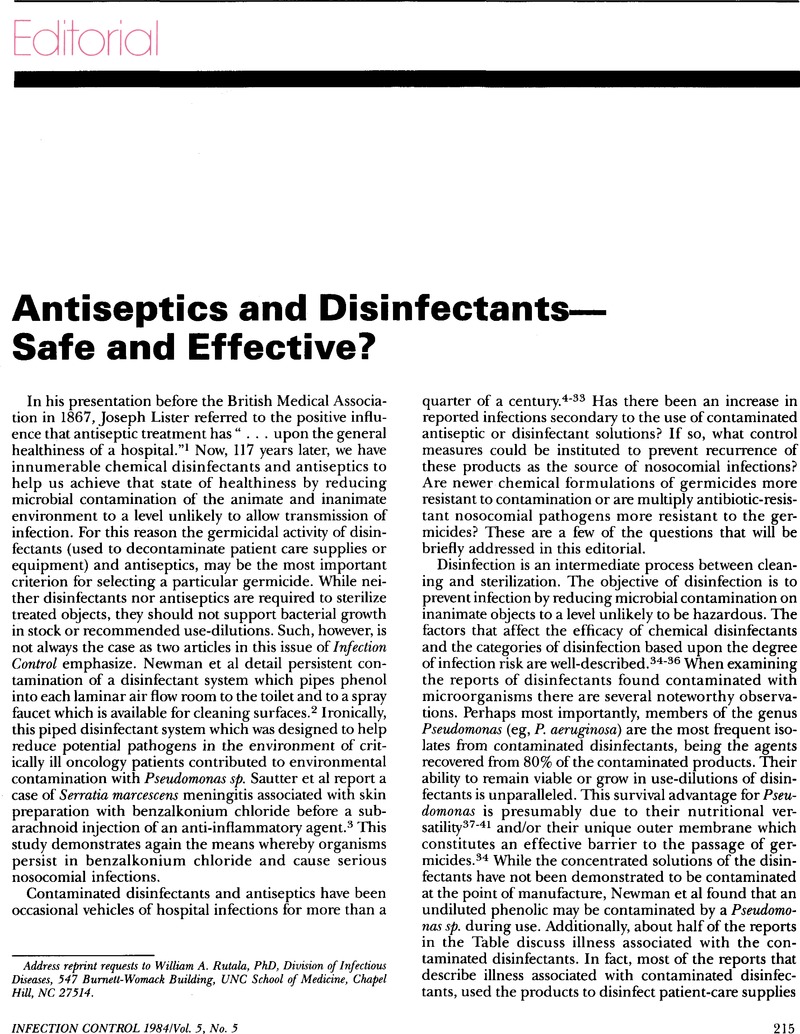Crossref Citations
This article has been cited by the following publications. This list is generated based on data provided by Crossref.
Reybrouck, G.
1985.
Vol. 9,
Issue. ,
p.
225.
Reybrouck, G.
1985.
The bactericidal activity of aqueous disinfectants applied on living tissues.
Pharmaceutisch Weekblad Scientific Edition,
Vol. 7,
Issue. 3,
p.
100.
Terleckyj, B
and
Axler, D A
1987.
Quantitative neutralization assay of fungicidal activity of disinfectants.
Antimicrobial Agents and Chemotherapy,
Vol. 31,
Issue. 5,
p.
794.
Springthorpe, V. Susan
and
Sattar, Syed A.
1990.
Chemical disinfection of virus‐contaminated surfaces.
Critical Reviews in Environmental Control,
Vol. 20,
Issue. 3,
p.
169.
Rutala, William A.
1990.
APIC guideline for selection and use of disinfectants.
American Journal of Infection Control,
Vol. 18,
Issue. 2,
p.
99.
Anderson, R L
Holland, B W
Carr, J K
Bond, W W
and
Favero, M S
1990.
Effect of disinfectants on pseudomonads colonized on the interior surface of PVC pipes..
American Journal of Public Health,
Vol. 80,
Issue. 1,
p.
17.
Donowitz, Leigh G.
1991.
Benzalkonium Chloride Is Still in Use.
Infection Control & Hospital Epidemiology,
Vol. 12,
Issue. 3,
p.
186.
Donowitz, Leigh G.
1991.
Benzalkonium Chloride Is Still in Use.
Infection Control & Hospital Epidemiology,
Vol. 12,
Issue. 3,
p.
186.
Rutala, William A.
1996.
APIC guideline for selection and use of disinfectants.
American Journal of Infection Control,
Vol. 24,
Issue. 4,
p.
313.
Oie, Shigeharu
and
Kamiya, Akira
1996.
Microbial contamination of antiseptics and disinfectants.
American Journal of Infection Control,
Vol. 24,
Issue. 5,
p.
389.
Barone, Mark A.
Jamil Faisel, Abu
Andrews, Linda
Ahmed, Jahiruddin
Rashida, Begum
and
Kristensen, Debra
1997.
Adaptation and validation of a portable steam sterilizer for processing intrauterine device insertion instruments and supplies in low-resource settings.
American Journal of Infection Control,
Vol. 25,
Issue. 4,
p.
350.
Vigeant, Patrice
Loo, Vivian G.
Bertrand, Céline
Dixon, Catherine
Hollis, Richard
Pfaller, Michael A.
McLean, A. Peter H.
Briedis, Dalius J.
Perl, Trish M.
and
Robson, Hugh G.
1998.
An Outbreak of Serratia marcescens Infections Related to Contaminated Chlorhexidine.
Infection Control & Hospital Epidemiology,
Vol. 19,
Issue. 10,
p.
791.
Vigeant, Patrice
Loo, Vivian G.
Bertrand, Céline
Dixon, Catherine
Hollis, Richard
Pfaller, Michael A.
McLean, A. Peter H.
Briedis, Dalius J.
Perl, Trish M.
and
Robson, Hugh G.
1998.
An Outbreak of Serratia marcescens Infections Related to Contaminated Chlorhexidine.
Infection Control & Hospital Epidemiology,
Vol. 19,
Issue. 10,
p.
791.
Saiman, Lisa
and
Siegel, Jane
2003.
Infection Control Recommendations for Patients With Cystic Fibrosis: Microbiology, Important Pathogens, and Infection Control Practices to Prevent Patient-to-Patient Transmission.
Infection Control & Hospital Epidemiology,
Vol. 24,
Issue. S5,
p.
S6.
Maillard, J.-Y.
2005.
Handbook of Hygiene Control in the Food Industry.
p.
641.
Toussaint, Michel
Steens, Marc
Van Zeebroeck, André
and
Soudon, Philippe
2006.
Is disinfection of mechanical ventilation tubing needed at home?.
International Journal of Hygiene and Environmental Health,
Vol. 209,
Issue. 2,
p.
183.
Weber, David J.
Rutala, William A.
and
Sickbert-Bennett, Emily E.
2007.
Outbreaks Associated with Contaminated Antiseptics and Disinfectants.
Antimicrobial Agents and Chemotherapy,
Vol. 51,
Issue. 12,
p.
4217.
Dolan, Susan A.
Dowell, Elaine
LiPuma, John J.
Valdez, Sondra
Chan, Kenny
and
James, John F.
2011.
An Outbreak ofBurkholderia cepaciaComplex Associated with Intrinsically Contaminated Nasal Spray.
Infection Control & Hospital Epidemiology,
Vol. 32,
Issue. 8,
p.
804.
Rutala, William A.
and
Weber, David J.
2011.
Sterilization, High-Level Disinfection, and Environmental Cleaning.
Infectious Disease Clinics of North America,
Vol. 25,
Issue. 1,
p.
45.
Staniforth, Lawrence
2012.
Russell, Hugo & Ayliffe's.
p.
236.



